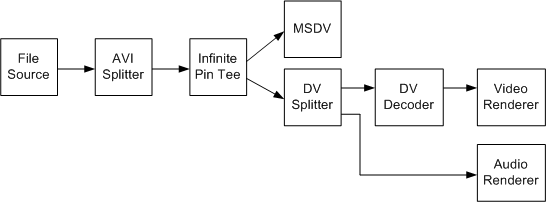Transmit from Type-1 File
[The feature associated with this page, DirectShow, is a legacy feature. It has been superseded by MediaPlayer, IMFMediaEngine, and Audio/Video Capture in Media Foundation. Those features have been optimized for Windows 10 and Windows 11. Microsoft strongly recommends that new code use MediaPlayer, IMFMediaEngine and Audio/Video Capture in Media Foundation instead of DirectShow, when possible. Microsoft suggests that existing code that uses the legacy APIs be rewritten to use the new APIs if possible.]
To transmit a type-1 file while previewing the file, use the filter graph shown in the following diagram.

Filters in this graph include:
- The AVI Splitter parses the AVI file. For a type-1 DV file, the output pin delivers interleaved DV samples.
- The Infinite Pin Tee filter splits the interleaved DV into a transmit stream and a preview stream. Both streams contain the same interleaved data. (This graph uses the Infinite Pin Tee instead of the Smart Tee, because there is no danger of dropping frames when reading from a file, as there is with live capture.)
- The DV Splitter splits the interleaved stream into a DV video stream, which is decoded by the DV Video Decoder, and an audio stream. Both streams are rendererd for preview.
Build this graph as follows:
ICaptureGraphBuilder2 *pBuilder; // Capture graph builder.
IBaseFilter *pDV; // DV capture filter (MSDV)
// Initialize pDV (not shown).
// Create and initialize the Capture Graph Builder (not shown).
// Add the Infinite Pin Tee filter to the graph.
IBaseFilter *pTee;
hr = CoCreateInstance(CLSID_InfTee, 0, CLSCTX_INPROC_SERVER
IID_IBaseFilter, reinterpret_cast<void**>)(&pTee));
hr = pGraph->AddFilter(pTee, L"Tee");
// Add the File Source filter to the graph.
IBaseFilter *pFileSource;
hr = pGraph->AddSourceFilter(
L"C:\\YourFileNameHere.avi",
L"Source",
&pFileSource);
// Add the AVI Splitter filter to the graph.
IBaseFilter *pAviSplit;
hr = CoCreateInstance(CLSID_AviSplitter, 0, CLSCTX_INPROC_SERVER
IID_IBaseFilter, reinterpret_cast<void**>)(&pAviSplit));
hr = pGraph->AddFilter(pAviSplit, L"AVI Splitter");
// Connect the file source to the AVI Splitter.
hr = pBuilder->RenderStream(0, 0, pFileSource, 0, pAviSplit);
if (FAILED(hr))
{
// This is not an AVI file.
}
// Connect the file source to the Infinite Pin Tee.
hr = pBuilder->RenderStream(0, &MEDIATYPE_Interleaved, pAviSplit, 0, pTee);
if (FAILED(hr))
{
// This is not a type-1 DV file.
}
// Render one stream from the Infinite Pin Tee to MSDV, for transmit.
hr = pBuilder->RenderStream(0, 0, pTee, 0, pDV);
// Render another stream from the Infinite Pin Tee for preview.
hr = pBuilder->RenderStream(0, 0, pTee, 0, 0);
- Call IGraphBuilder::AddSourceFilter to add the source filter to the filter graph.
- Create the AVI Splitter and the Infinite Pin Tee, and add them to the graph.
- Call ICaptureGraphBuilder2::RenderStream to connect the source filter to the AVI Splitter. Specifying MEDIATYPE_Interleaved to ensure that the method fails if the source file is not a type-1 DV file. In that case, you can back out and attempt to build a type-2 transmit graph instead.
- Call RenderStream again to route the interleaved stream from the AVI Splitter to the Infinite Pin Tee
- Call RenderStream a third time to route one stream from the Infinite Pin Tee to the MSDV filter, for transmit to the device.
- Call RenderStream one last time, to build the preview section of the graph.
If you do not want preview, simply connect the file source to the MSDV filter:
hr = pBuilder->RenderStream(0, &MEDIATYPE_Interleaved, pFileSource, 0, pDV);
Related topics